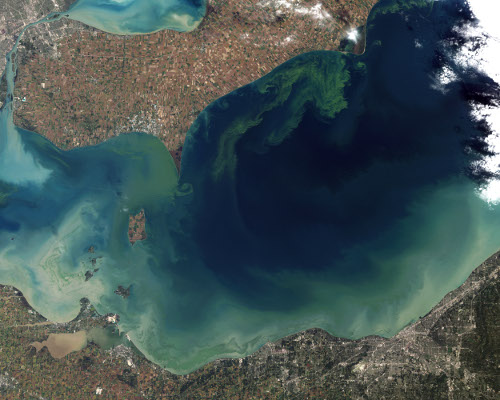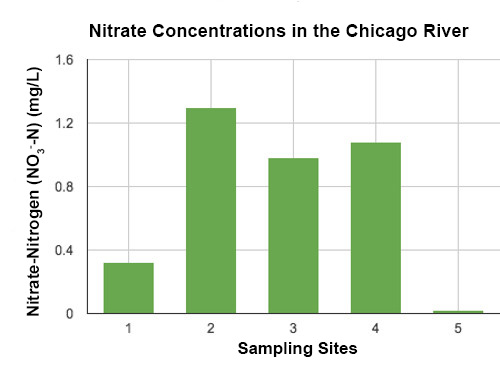Nutrients in Aquatic Ecosystems
Source: Laboratories of Margaret Workman and Kimberly Frye - Depaul University
Nitrogen and phosphorus are essential plant nutrients found in aquatic ecosystems and both are monitored as a part of water quality testing because in excess amounts they can cause significant water quality problems.
Nitrogen in water is measured as the common form nitrate (NO3-) that is dissolved in water and readily absorbed by photosynthesizers such as algae. The common form of phosphorus measured is phosphate (PO43-), which is strongly attracted to sediment particles as well as dissolved in water. In excess amounts, both nutrients can cause an increase in aquatic plant growth (algal bloom, Figure 1) that can disrupt the light, temperature, and oxygen levels in the water below and lead to eutrophication and hypoxia (low dissolved oxygen in water) forming a “dead zone” of no biological activity. Sources of nitrates and phosphorus include wastewater treatment plants, runoff from fertilized lawns and agricultural lands, faulty septic systems, animal manure runoff, and industrial waste discharge.

Figure 1. Algal bloom
Taken in 2011, the green scum shown in this image was the worst algae bloom Lake Erie has experienced in decades. Record torrential spring rains washed fertilizer into the lake, promoting the growth of microcystin producing cyanobacteria blooms. Vibrant green filaments extend out from the northern shore.
1. Measure Nitrogen in Sample
- On the spectrophotometer, find the program for nitrate (with user manual or instrument menu) and enter the program number.
- Pipette 10 mL of the water sample into one of the sample tubes. Pour this into one of the sample tubes.
- Repeat for a second sample tube.
- Add the contents of one nitrate reagent powder pillow to one sample tube.
- Cap both sample tubes.
- On the spectrophotometer, press timer and enter to start a r

Figure 2. Graph comparing nitrates between different land use types (undeveloped, agricultural, and urban).
Average nitrate concentrations compared upstream and downstream from a water treatment plant (Figure 3). The downstream measurement represents the discharge from the treatment.
High concentrations of nitrates and phosphorus can stimulate eutrophic conditions in water by causing algal bloom that negatively affects other water quality factors including dissolved oxygen, temperature, and other indicators. Excess nitrates can lead to hypoxic water (low levels of dissolved oxygen) no longer able to support aerobic life creating a “dead zone,” where non-mobile species mass die-offs and mobile species move away to other waters. Dead zones are occurring globally in coastal regions where lar
Saltar a...
Vídeos de esta colección:

Now Playing
Nutrients in Aquatic Ecosystems
Environmental Science
38.8K Vistas

Tree Identification: How To Use a Dichotomous Key
Environmental Science
81.1K Vistas

Tree Survey: Point-Centered Quarter Sampling Method
Environmental Science
49.3K Vistas

Using GIS to Investigate Urban Forestry
Environmental Science
12.5K Vistas

Proton Exchange Membrane Fuel Cells
Environmental Science
22.0K Vistas

Biofuels: Producing Ethanol from Cellulosic Material
Environmental Science
53.1K Vistas

Testing For Genetically Modified Foods
Environmental Science
89.5K Vistas

Turbidity and Total Solids in Surface Water
Environmental Science
35.8K Vistas

Dissolved Oxygen in Surface Water
Environmental Science
55.6K Vistas

Measuring Tropospheric Ozone
Environmental Science
26.4K Vistas

Determination Of NOx in Automobile Exhaust Using UV-VIS Spectroscopy
Environmental Science
30.0K Vistas

Lead Analysis of Soil Using Atomic Absorption Spectroscopy
Environmental Science
125.3K Vistas

Carbon and Nitrogen Analysis of Environmental Samples
Environmental Science
29.3K Vistas

Soil Nutrient Analysis: Nitrogen, Phosphorus, and Potassium
Environmental Science
215.6K Vistas

Analysis of Earthworm Populations in Soil
Environmental Science
16.4K Vistas
ACERCA DE JoVE
Copyright © 2025 MyJoVE Corporation. Todos los derechos reservados